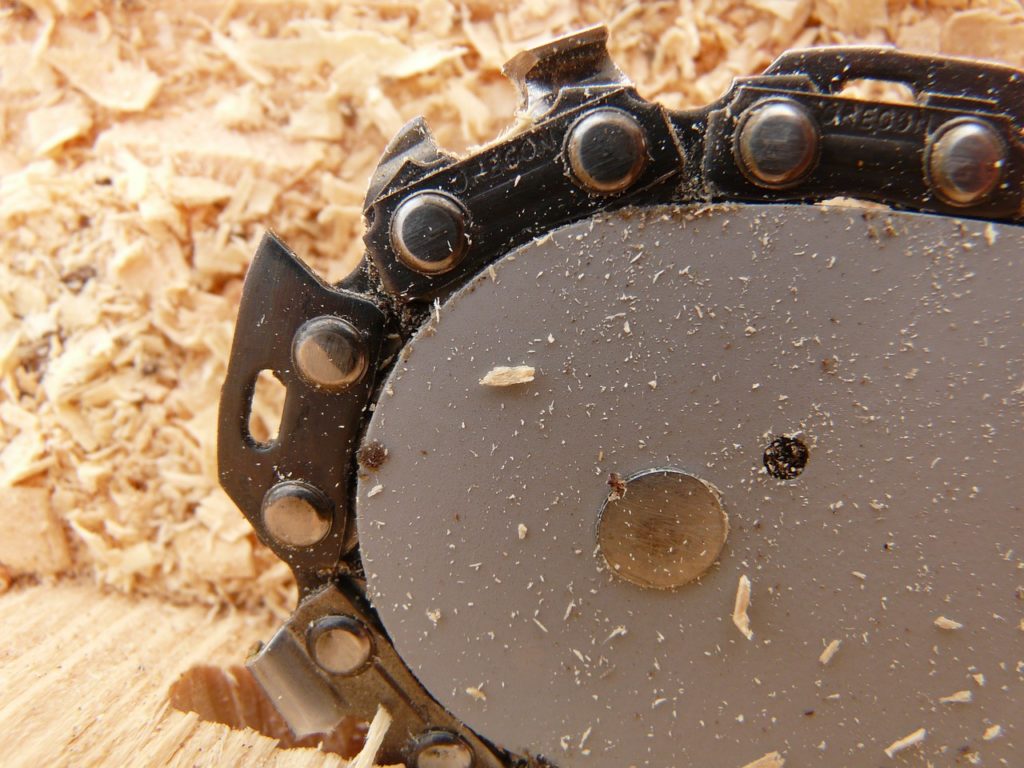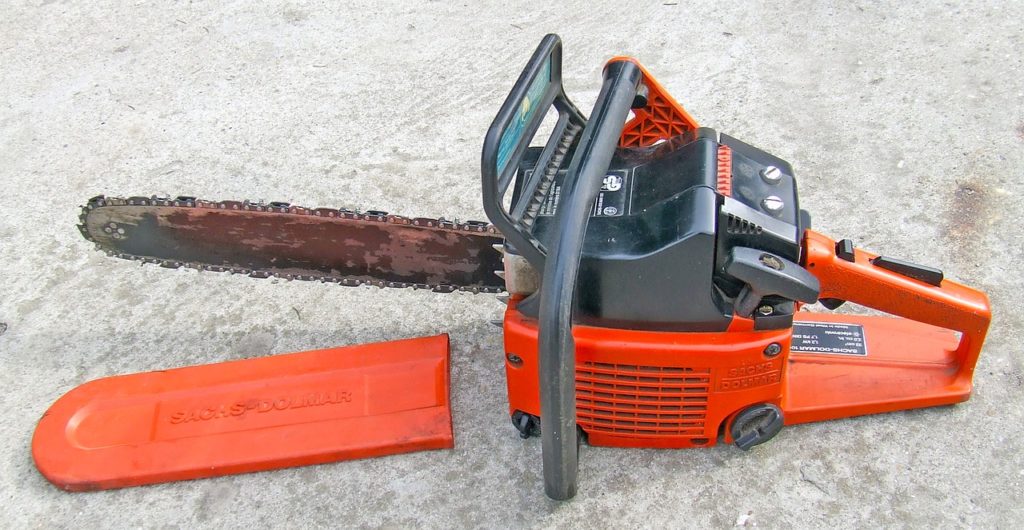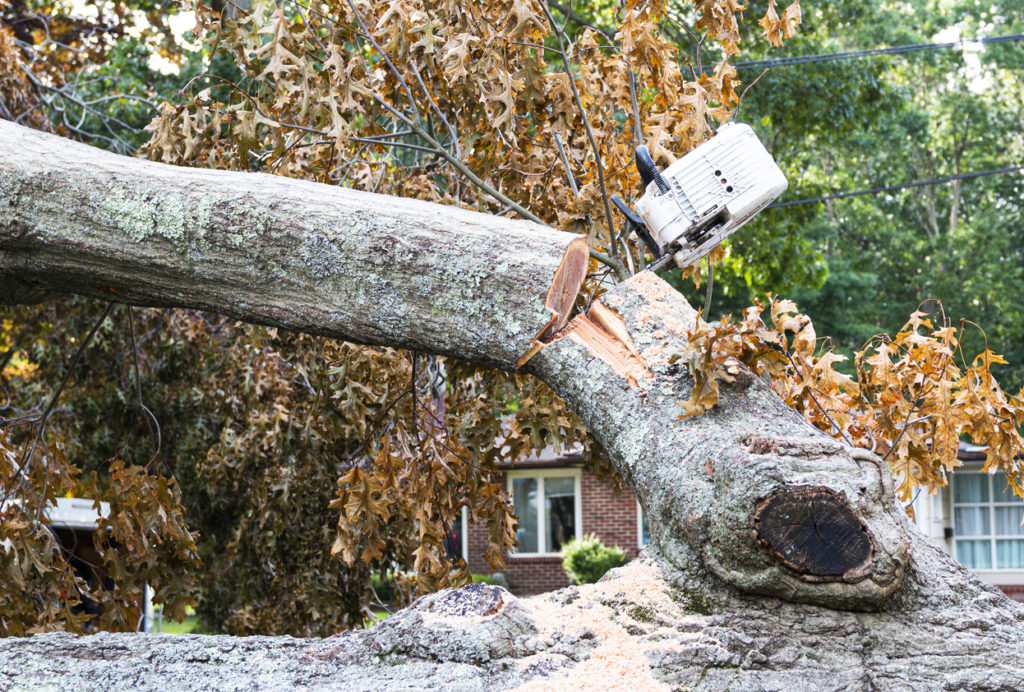Wielding a chainsaw can make you feel powerful. It makes quick work of demolition, pruning, tree felling, and woodworking. But a chainsaw that won’t cut is useless. Besides being ineffective, it’s frustrating. If your chainsaw is not cutting, keep reading to find out how to troubleshoot the problem.
The Chain Might Be Dull
The most likely reason that your chainsaw is not cutting is that the chain is dull. Some signs of a dull chain include the following:
- You have to press down harder than usual to cut the material.
- The chainsaw is smoking even if it’s well-lubricated.
- The cuts are uneven.
- The tool produces fine sawdust instead of thick fibers when you cut against the grain.
- The chainsaw jerks and rattles while you make a cut.
- 4 PACK 14 INCH CHAIN: 3/8" LP Pitch .050" Gauge 52 Drive Links, please check the length and drive links, to ensure this 14 inch chain works with your machine. Suitable for most 14-inch pole saw. This saw chain met the kickback performance requirement of ANSI Standards.
- REPLACEMENT CHAINS FOR 14-INCH CHAINSAW CHAIN Compatible for most chainsaw, Compatible for Craftsman, Echo, Ryobi, Poulan, Homelite, Husqvarna, Remington, Earthwise, Makita, Chicago, Greenworks, Sun Joe, Worx, etc. Compatible for 14 inch chainsaw chain 3/8" LP Pitch .050" Gauge 52 Drive Links pole saw.
- LOW KICKBACK CUTS SMOOTHLY: 14 inch chainsaw chain is deeply quenched to ensure smooth cutting and optimal lubrication. The service life of the saw chain is longer, wear-resistant, cuts smoothly and fast with minimum kickback. With high hardness, the carving chains are not easy to break, durable and practical.
- 14 INCH CHAINSAW CHAINS COMPATIBLE FOR Craftsman S145, S1450, CMECS614, Echo CS310. Greenworks - 12A Electric 20022, 12A Electric 20232, 2020902ME, 9A Electric 20012, 9A Electric 20222. Sun Joe SWJ699E, SWJ701E. Poulan PR4218, PL3314. Ryobi RY3714, RY40503, RY40530, RY43006. Makita UC4051A, XCU03, XCU04.etc.
- EASY TO INSTALL AND REPLACE, stronger connection, Heat treated and quenched rivets make stronger connection between chain links. This 14-inch pole saw chain has a product warranty. If you have any questions about this 14 inch replacement chain, please feel free to contact us.
How Does a Chainsaw Chain Become Dull?
Every time you cut something, you wear down the chain. The sharpness of the cutting surface deteriorates even faster when you do things like making contact with the ground and cutting dirty trees. Abrasive dirt particles that linger on tree bark and the ground sand away the sharpness of the chain. Cutting through wet wood, ice, nails, and hard foreign objects will dull the chain rapidly, too.
There are a few ways to delay the wear and tear on the chainsaw chain. When cutting trees, use an ax or hatchet to remove the bark at the intended location of the cut. Avoid cutting items directly on the ground so that you don’t make contact with the earth accidentally. Store and handle your chainsaw properly. Avoid dropping it or letting the chain get rusty.
How to Sharpen a Chainsaw Chain

No matter how careful you are with your tool, the chainsaw chain will get dull from time to time. You can always replace the chain. In fact, replacing it is the best option if it has significant chips or has reached the end of its lifespan.
However, it’s more affordable and convenient to sharpen it. With proper maintenance, a chainsaw chain should last five or six years. And if you accidentally hit a rock or nail in the middle of a project, understanding how to sharpen a chainsaw chain will get you back on track quickly.
Unless you have an electric chainsaw sharpener, you’ll need a chainsaw file for this job. Choose the chainsaw file size that corresponds with the size and shape of the teeth on the chain. The most frequently used sizes are 3/16 inches, 5/32 inches, and 7/32 inches.
Follow the steps below for how to sharpen a chainsaw chain:
- Wear safety equipment, such as safety glasses.
- Clean the chain thoroughly to remove all residue and debris.
- Adjust the tension so that you can pull the chain away from the tool slightly and snap it back into place when you let go.
- Stabilize the chainsaw in a vise.
- Start with the shortest cutter blade, which has a flat head, marking it to remember where you began.
- Fit the file into the notch at the edge of the cutter, matching its angle as you slide it across the teeth. Repeat this for every other cutter along the chain.
- Flip the saw around, and use the same technique to file the cutters that you left out the first time.
- All the cutters should be about the same size when you finish.
- Finally, make sure that the rakers, the arched connections between the cutters, are slightly shorter than the adjacent cutters.
Tips for Sharpening Your Chainsaw Chain
Here are some quick tips for sharpening your chainsaw chain:
- Wear gloves to avoid getting cut.
- Use a file guide to maintain the proper angle; look for a mark on the tooth that shows you the proper angle.
- Use both hands to apply enough pressure.
- Always point the file away from the chainsaw engine; if you point it in the wrong direction, you’ll feel a lot of resistance and skipping.
- Don’t file in a back-and-forth motion.
- Durable ➡ The latest, hardest titanium-coated diamond WHEEL we’ve ever made, owns a long lifetime. So you don't have to replace it often, 6 pcs [5/32''×2, 3/16'' ×2, 7/32'' ×2] of wheels are provided which can help sharpen any of the chains out there. Less but better.
- Easy to Use ➡ No chain removal required, No replacement parts needed, Only 4 installation steps are needed at the first time of usage, and an easy-to-follow VIDEO is provided. Let's simplify your sharpening work with this helpful Chain saw Sharpener.
- Fast Result ➡ This is a HIGH-POWER sharpening tool, which means that even sharpen the bluntest chain, you can see how quickly your sharpening work could be done just in a few minutes. And get rid of troublesome hand sharpening once and for all. This is a great replacement for hand chain saw file/ sharpener.
- Accuracy ➡ With the Angle Attachment' help, see how easily you can be a professional and sharpen chainsaw blade at an exact angle & depth, which can efficiently makes the chain razor-sharp & protects the chain from wrong-angle damage. Thus, getting you chain back to razor sharp is no longer a unique ability of hand files.
- Perfect Assistant ➡ This efficient chainsaw sharpener is the perfect companion for chainsaws. It sharpen the chain, protects the chain, makes work easier & safer than ever before. And the exquisite packaging makes it a unique and practical GIFT for father husband and logger. So, get it and you will find you are a cool working style leader!
Improper Installation
If your chainsaw is not cutting, the chain might be installed incorrectly. The blade rotates in a clockwise direction, and the sharp edges of the cutters must face out to chip away at the wood. If the chain is installed backward, it can make your chainsaw get stuck or kick back. It will also cause an intense rattle if you try to cut through the material.
How to Replace the Chain
Follow the steps below to remove the chain and reinstall it properly:
- Turn off the tool, and wear protective gloves.
- Remove the side panel, and unlock the brake.
- Pry the chain off, starting at the nose.
- Loosen the tensioning screw on the interior of the guide bar to make it easier to reinstall the chain.
- Position the chain so that the cutters are facing the proper direction, and thread it back onto the saw.
- Replace the side plate.
- Adjust the tension of the chainsaw chain.
Incorrect Tension
Incorrect tension can contribute to a chainsaw’s failure to cut. If the chain is too tight, it won’t grab the wood or rotate freely. It also puts excess tension on the drive sprocket, wearing it out too soon. A loose chain might be even more dangerous. It can release from the tool and lash back, cutting you. It also has trouble making smooth contact with the material that you’re slicing.
To determine if the chain tension is right, hold the saw with the bar perpendicular to the ground. If the chain is sagging at the bottom, it’s too loose. However, if you can’t pull the chain away from the bar at all, it’s too tight. Adjust the tensioning screw until the chain is just right. You should be able to pull it away from the bar about a quarter of an inch. But when you let go, it should return to the correct position without any adjustment on your part.
How to Tighten a Chainsaw Chain
Use the following steps to tighten a chainsaw chain:
- Loosen the bar nuts.
- Locate the tensioning screw.
- Rest your forearm on the brake, and pull up on the bar.
- Maintain this position as you turn the screw clockwise to tighten or counterclockwise to loosen the chain.
- Test the tension of the chainsaw chain.
- Keeping the bar lifted, tighten the bar nuts.
- Test the tension again, repeating the steps above if necessary.
Where Is the Tensioning Screw on Your Chainsaw?
The tensioning screw is inside the front cover of most chainsaws. On a Stihl chainsaw, the screw lies between the dog and the bar, facing the front of the bar. The tensioning screw on a Husqvarna is on the exterior of the bar cover, on the side of the unit. If you can’t find the tensioning screw, refer to the owner’s manual.
The Chain Bar Is Damaged
The chainsaw bar should outlast the chain. However, it should be replaced if it becomes damaged. A bent, worn, or pinched bar can make you wonder why your chainsaw is not cutting.
Dropping your chainsaw or using it improperly can bend the bar. This prevents the chain from tracking properly. You can fix a minor bend by removing the bar from the tool and placing it on a flat surface. Use a rubber mallet to pound it back into shape. If the bar has a serious bend in it, however, it may need to be replaced.
A damaged bar not only makes it harder to use the chainsaw but also damages the chain. It can make your chain wear out prematurely or snap while you’re using it, creating a dangerous situation.
How to Tell If Your Chainsaw Bar Is Worn
Other types of wear and tear can also create inaccurate, inefficient cuts. If your chain is sharp and the tension is correct, check the bar for wear and tear. Take the following steps to determine whether your chainsaw bar is worn:
- With the chainsaw off, use one finger to rock the chain back and forth. Significant movement indicates that the bar is worn.
- Look for burrs at the edges of the bar.
- Check for chips, dips, and missing chunks on the edges of the bar.
- Make sure the groove inside the edges of the bar isn’t pinched.
- Check for excessive wear, which can widen the edges of the bar, making it difficult for the chain to cut properly.
- Replace the bar if the nose sprocket doesn’t turn.
There Are Problems With the Chainsaw Clutch
Even though you don’t have to shift gears when you use a chainsaw, you should know that the motor has a clutch. This allows the chain to stop turning when the tool is idling.
If the chainsaw clutch is broken, the chain might not stop spinning. However, the chain might not turn at all even if the engine is revving.
Worn-out clutch pads and jammed springs can contribute to a chainsaw’s failure to cut properly. If the clutch pads aren’t as thick as they used to be, they won’t put enough pressure on the clutch drum. Therefore, the chain won’t cut adequately.
The issue could also be that the clutch band isn’t working right. This part envelops the clutch drum when you press the emergency stop button. It may need to be adjusted if the chainsaw won’t turn after you depress the stop lever.
How to Replace the Chainsaw Clutch Assembly
Replacing the clutch assembly is a relatively straightforward job that involves the following steps:
- Remove the chainsaw’s top cover, clutch cover, bar, and chain.
- Use a special tool to bind the piston so that it doesn’t move as you turn the clutch.
- Turn the chainsaw clutch in a clockwise direction to remove it, striking it with a screwdriver and hammer if it won’t unlock.
- Replace the clutch assembly according to the manufacturer’s directions.
- Fit models: 044 044 W 044 R 044 C 046 046 W 046 C 046 Magnum 046 Magnum R 046 WVH 046 Magnum BR, 066 066 W 066 M 066 MR 066 Arctic 066 BR MS 440 MS 440-D MS 440-N MS 440-W MS 440-Z and etc.
- Fits for 45/52/58 2 Cycle Chain Saw.
- Fits for Husqvarna and Stihl Echo 2 Cycle.
- Easy to use and very handy when doing your own saw or any other 2-cycle work.
- Please make sure the item is the one which you need before order.
Check the Brake
Sometimes, the brake can move out of position when you’re doing all this fiddling around to determine why your chainsaw is not cutting. If you have removed and reinstalled the side panel, you could have shifted the brake lever without knowing it. Try removing the panel again. Put the lever in the correct position before replacing the panel. If this doesn’t work, but you think the brake lever is keeping the chainsaw from cutting, you can replace the brake.
What If an Electric Chainsaw Is Not Cutting?
If you have an electric chainsaw, you can go through the list above to check its performance. However, you must also pay attention to the power source. Make sure that your extension cord is rated for the power tool’s capacity. Also, make sure the batteries are fully charged.
Maintain Your Chainsaw Blade for Optimal Performance

Proper maintenance will help you get the most life out of your chainsaw. When all of the components are working in harmony, the chain will have the best chance of retaining its sharpness.
You’ll generally need to sharpen the chainsaw chain after every three hours of cutting. If you avoid sharpening the chain, you’ll run into issues with the chainsaw not cutting. Eventually, this contributes to other parts deteriorating more rapidly than they’re supposed to.
You also need to keep the chainsaw clean and dry. If the chainsaw is exceptionally dirty, soak the chain in a solution of ammonia and water for 30 minutes to loosen the residue. Then, scrub it with a soft brush. Rinse it with fresh water, and allow it to dry.
Lubricate your chainsaw properly, too. This process differs between manufacturers. Check your owner’s manual for the right way to oil the chainsaw.
If you maintain your chainsaw well, it may never balk when you want it to cut. However, if the tool isn’t cutting effectively, the steps above should enable you to troubleshoot and resolve the problem.



